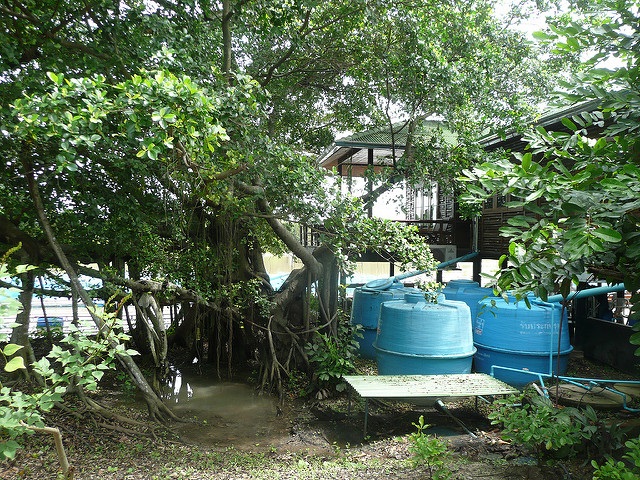You’ve probably heard those gloomy predictions that water is likely to be the focus of many wars and conflicts to come. Those lucky enough to live in parts of the world where there’s plenty of water often take it for granted, while those living in areas where water appears in limited supply have long ago become aware of its significance to their survival.
Among the strategies employed to tackle the issue of water shortage and sustainability, one of the most popular and inexpensive is rainwater harvesting. This notion refers to the collection of water from various surfaces and its storage for future use. In most cases we’re talking about water being collected from roofs and stored in special tanks, but it can also be the case that water is collected in dams, when rain falls on the ground and produces runoff.
How is water collected?
Basically, every roof can be used to collect water. The key issue is to direct the flow of water from roof gutters to a tank. This water can be used for various purposes.
Such water is crucial if you’re not connected to the town water supply, since it should cater to almost all your needs involving water. However, in most cases, the water you collect from your roof is used to supplement your fresh water requirements. How big this portion is depends on many factors.
Why should I harvest rainwater?
- First of all, we are increasing our independence from water storage dams by becoming less reliant on them to provide water.
- Another important reason is that by retaining water, there’s less storm water and, hence, chance of overloading the systems in our neighborhoods.
- Last but not least, our water bills can be much lower.
How to avoid collecting dirt from the roofs?
We know there are leaves, twigs and other kinds of dirt on the roof. To prevent them from ending up in the storage tank, there are so-called “first flush” devices, which allow for the first flow of water to be diverted from the tank. That way, the dirt on the roofs doesn’t contaminate the harvested water.
How big should the tank be?
This is probably the trickiest stage in the process. How to get the size of the tank right? To do this, you need to be familiar with the information about historical daily rainfall and the size of the area from which you’re harvesting water (e.g. the roof). The larger the area, the more rainfall can be harvested.
Depending on this input and your requirements, you’re going to choose one of those capacious cartage tanks. Feel free to consult a professional or a shop assistant about this.
What’s also important is to take into consideration the fact that the tank is large enough to hold water supplied from other sources to make up for any shortfall in demand.
What can I use it for?
It’s primarily used for watering gardens and irrigation, as well as indoor heating. However, with proper treatment, this rainfall can be used as drinking water, it can be stored for longer periods and other uses, such as groundwater recharge.
Latest developments
People are looking into options beyond rooftops alone. There are stand-alone structures which resemble upside-down umbrellas, which are very efficient in harvesting rainwater. Also, there are devices which act as incubators, protecting plants from the sun, while at the same time preserving as much precious water as possible.
Finally, there’s been major developments in the field of bioswales, which are landscape elements created to eliminate silt and pollution from surface runoff water.
In conclusion, it should be said that rainwater harvesting is likely to become even more important in the future and we can expect some new technologies being developed to assist the process, which might be the difference between life and death in or a global crisis in some parts of the world.
Shared on OUR SIMPLE HOMESTEAD BLOG HOP!
Shared on LETS GET REAL FRIDAYS BLOG HOP!
Shared on SIMPLY NATURAL SATURDAYS!
Shared on HEALTHY LIVING LINK UP!


Pingback: Tips On How To Save Water In The Vegetable Garden
I collect rainwater using a tarp since my garden is far from my home. It works very well and I store the water in two connected 55-gallon plastic barrels. It isn’t enough to last me through the summer, but at least gets my plants going before the hot weather arrives. – Margy
HI Margy,
I glad to hear that you are have found and unique way of harvesting water and it works for you. There are many ways we can save water and reduce our carbon footprint. Thanks for reading my article, commenting and please stop back for regular updates. Have a healthy happy & blessed day!
Los Angeles needs to get on this… WHEN IT ACTUALLY RAINS! 🙁
HI GiGi,
I think all areas of our country should be doing everything they can to preserve water and energy, especially the areas that don’t get much rainfall. Thanks for stopping by and commenting. Have a healthy, happy & blessed day!
Excellent post, packed full of helpful information. Thanks Marla for sharing. Nancy Andres @ http://www.colors4health.com
HI Nancy,
Thanks for your compliments, stopping by and commenting. Conserving is water is so important to conserving our planet. Have a healthy, happy & blessed day!